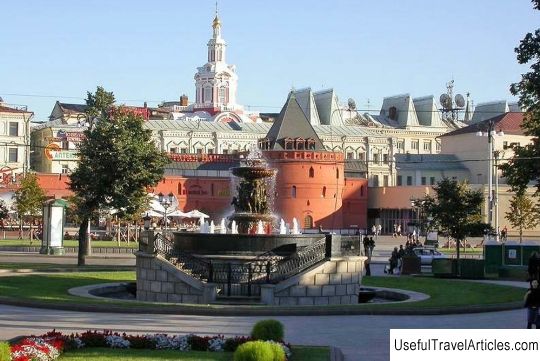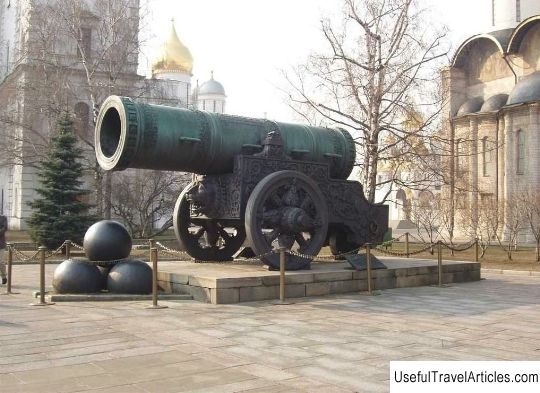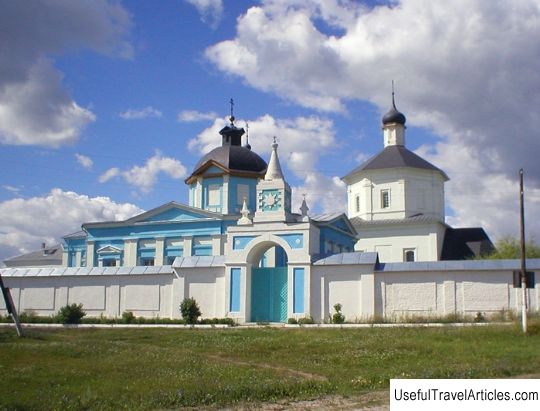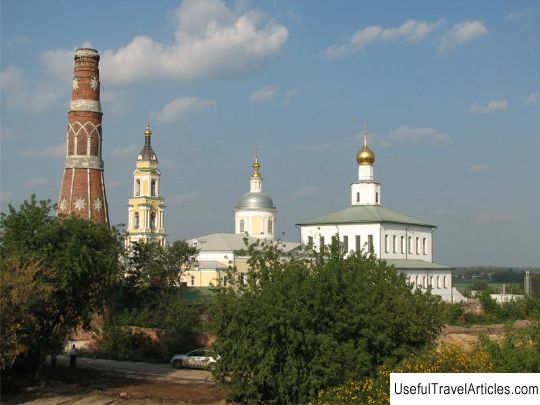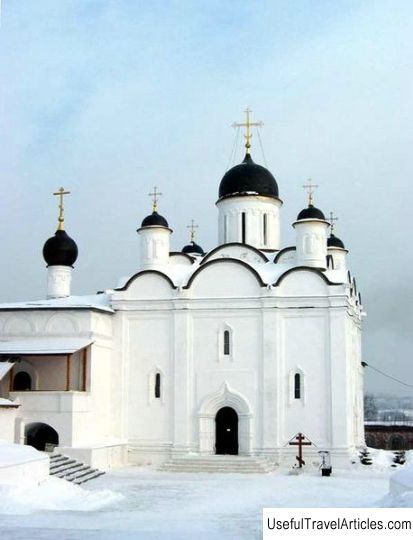Donskoy Monastery description and photos - Russia - Moscow: Moscow
Rating: 8,3/10 (860 votes) 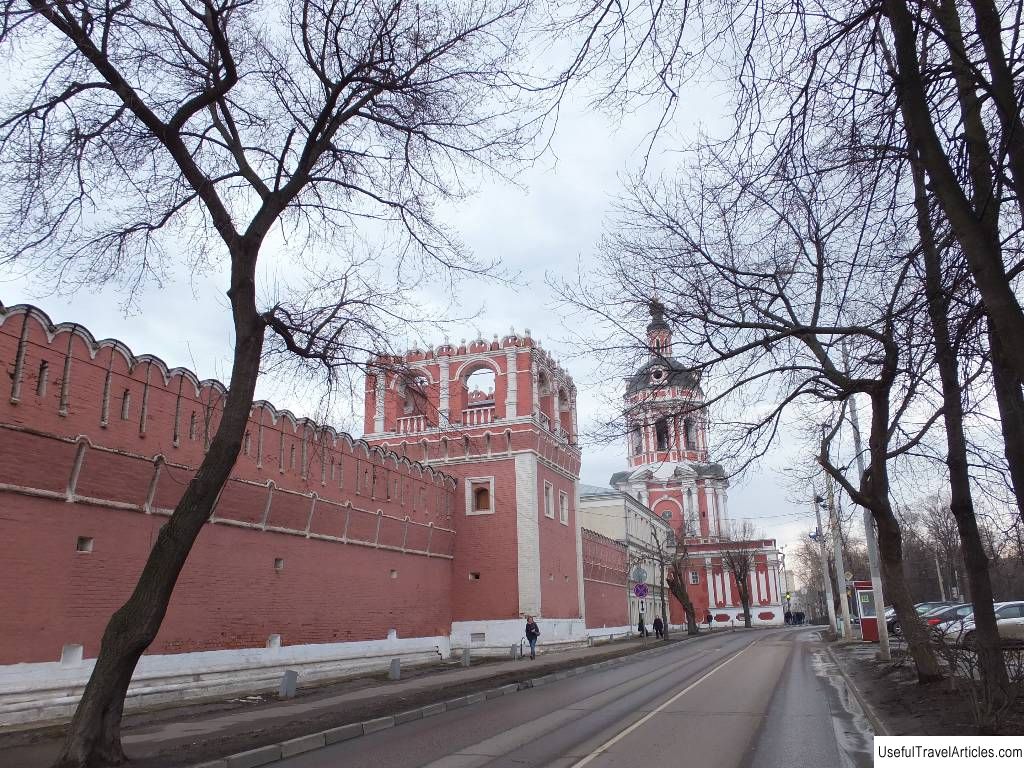
Donskoy Monastery description and photos - Russia - Moscow: Moscow. Detailed information about the attraction. Description, photos and a map showing the nearest significant objects. Photo and descriptionAt the end of the 16th century, a new male monastery appeared in Moscow. It was founded on the place where the Russian army successfully repelled the raid of the Crimean Nogai army, ruled by Gaza II Giray. Today the Donskoy Monastery has the status of a stauropegic and is directly subordinate to the Patriarch. The history of the founding of the monasteryIn the summer of 1591, the 150-thousandth army of the Crimean x Ana Gaza II Girey approached Moscow. The Russian army was commanded by commanders Boris Godunov and Fyodor Mstislavsky . To repel the attack of the Crimean army, a field fortification called the gulyai-gorod was assembled under the walls of Moscow. It was a complex of sturdy carts, reinforced with shields and capable of forming a small mobile fortress. Walk-city could help the infantry to reflect the attack and even hold the enemy cavalry for quite a long time. Gulyai-gorod played an important role in the battle of 1591 near Moscow. The Russian cavalry was able to retreat in time under the protection of their mobile fortifications, while the enemy remained under fire and could not take cover. As a result of competent military tactics, the Russian army won a victory, and the khan's army disgracefully fled. On the site of the military camp, which was defeated by the army of Boris Godunov, on the initiative of Tsar Fyodor Ioannovich , a monastery was founded ... It became part of the defensive lines on the outskirts of Moscow. The semicircle also included other monasteries, which at that time in Russia more resembled fortresses. The new monastery was named after the icon painted by Theophanes the Greek. The image of the Donskoy Icon of the Mother of God has been known since the Kulikovo battle. It was with this icon that St. Sergius of Radonezh blessed the soldiers of Grand Duke Dmitry Ivanovich for battle. Construction of the monastery The first building on the territory of the new monastery was erected in honor of the sacred icon. The author of the project of the cathedral of the Donskoy Icon of the Mother of God was the architect Fyodor Kon ', famous for the construction of stone towers and walls of the White City of Moscow. The cathedral began to be called Old or Small. It was crowned with one chapter and did not bear much resemblance to the classical monastic cathedrals. After the accession to the throne of Mikhail Romanov , the temple had to be restored: it was plundered and almost destroyed during the Time of Troubles. In the second half of the 17th century, the cathedral received two chapels in honor of the victory over the Turkish troops in the battle of Chigirin and was painted with frescoes. The construction of the Great Cathedral of the Donskoy Monastery began in 1684 , but the construction was delayed due to eternal problems with funding: the treasury of the monastery was pretty devastated and was practically not replenished due to the Crimean campaigns. By 1698, the cathedral was nevertheless completed. The architects chose the so-called " Naryshkin style " as an architectural direction. It is characterized by a symbiosis of several directions in architecture - from Baroque and Renaissance to Mannerism. The cathedral was erected on a high basement, its chapters were oriented to the cardinal points, and masters worked on the iconostasis, who worked in the Ambassadorial Prikaz and the Armory. The next century was the most important in the history of the formation of the Donskoy Monastery ensemble. In 1711, the construction of the stone fence of the monastery with a dozen guard towers was completed. Funds for the construction of the monastery walls were donated by the son of the Duma clerk Kirillov. Three years later, a church in honor of the Tikhvin Icon of the Mother of God was laid over the northern entrance to the monastery. In 1730, a bell tower began to be built over the western gate. The author of the first project was Pietro Antonio Trezzini , a Swiss by origin and a renowned Baroque master. In 1749 the construction was headed by Dmitry Ukhtomsky , who was during the reign of Elizaveta Petrovna chief Moscow architect. Completed the project In 1753, Alexey Yevlashev , who also specialized in Elizabethan Baroque. In the quadrangle of the bell tower, a church in honor of Zechariah and Elizabeth was erected and consecrated, and the second tier of the tower housed the throne of the Church of Sergius . In the 80s of the 18th century, the walls of the Great Cathedral were painted ... The author of the frescoes on biblical themes is the Italian Antonio Claudo . A little later, the external image of the Great Cathedral was changed. As a result of the construction work, the roof took a different shape, the main volume of the quadrangle was built on, and burial places for the rectors of the temple were created under the tent bell tower. Wars and revolutions During the Patriotic War 1812 the monastery was badly damaged. The French set up the cavalry regiment's barracks in the Donskoy Monastery, and all the valuables were plundered and taken away. Precious crowns and frames were removed from the images, vestments and silver utensils were destroyed and stolen, and even the floors and doors of temples and cells were cut down and burned. The monastery was restored at the expense of Count Matvey Platonov , the former ataman of the Don Cossack army. The wind of revolutionary changes in 1917 brought the closure order to the Donskoy Monastery, as well as to many other religious institutions. The treasury chambers of the monastery served in the 20s a prison for the Patriarch of Moscow and All Russia Tikhon , and since 1926 the Donskoy monastery was declared a historical, cultural and household museum . In this hypostasis, it existed for three years, and then the museum was renamed anti-religious. A new stage in the life of the Donskoy Monastery began in the 30s of the last century. The monastery was handed over to the Museum of Architecture and they began to bring the preserved details and fragments of religious buildings and architectural monuments destroyed by the new government. Parts of the Cathedral of Christ the Savior, the Triumphal Gate of Osip Bove, the Cathedral of the Assumption of the Mother of God on Pokrovka and the Sukharev Tower were found in the monastery. After the war, divine services were allowed to be held in the Small Cathedral, and until 1960 they were held regularly. Then the temple operated only on holidays, until in 1991 monastic life was revived in the monastery. By the decision of the Moscow City Executive Committee, the churches of the Donskoy Monastery returned to the fold of the Orthodox Church. What to see in the Donskoy Monastery The architectural ensemble of the Donskoy Monastery consists of of several temples, the oldest of which is Small Cathedral . The temple was built in the tradition of Moscow stone architecture of the 16th century. It looks light and at the same time voluminous thanks to the three-tiered pyramid of kokoshniks, which is crowned with a dome on a slender drum. The temple was painted by the icon painters of the Armory Leonty Chulkov and Fyodor Evtiev . On an excursion to the Donskoy Monastery you can see other churches and temples: - The architectural dominant of the monastery is called The Great Cathedral . It is built in the shape of a flower, the petals of which are crowned with four heads, oriented to the cardinal points. A large chapter is installed in the center. The church houses the richest iconostasis, made at the end of the 17th century by the masters Karp Zolotarev, Abrosim Andreev and Grigory Alekseev. Most of the images in the iconostasis of the Great Cathedral were painted in the 17th century. - The Gate Church of the Tikhvin Icon of the Mother of God opposite the Great Cathedral was built in the Moscow Baroque style. The interior of the church is covered with vaults with open arches, which makes the interior of the church very light and airy. The iconostasis of the church was made in 1782. - In the lower part of the bell tower of the monastery in 1755 a temple was built in honor of the righteous Zacharias and Elizabeth . Countess Sophia Golovina was the initiator of its creation. In 1812 the French ravaged the monastery and the small church was destroyed. It was restored only in the 90s of the last century. At the end of the work, the artist N. Ermakova painted the arch of the entrance gate, over which the temple is located, with stories from the history of the monastery. - The most beautiful church of the Donskoy monastery bears the name of St. John Climacus . It was built at the end of the 19th century with donations from General I. Tereshchenko, who wished to have a family necropolis on the territory of the monastery. Later the tomb was rebuilt and a church in the style of Russian historicism appeared. It is distinguished by an abundance of decorative elements and moldings on the facades. - The Byzantine architectural style was chosen by the architect Alphonse Vincent for the construction of the Church of St. John Chrysostom and the Great Martyr Catherine . The temple was built with the money of E. Pervushina in memory of her husband. - The Church of Michael the Archangel appeared in the Donskoy Monastery in the early 19th century. It was built on the site of the old temple of Efimiy the Great with donations from Princess A. Golitsyna. The architectural style that the architect Ivan Egotov preferred while working on the project is called the Russian Empire style. The last restoration of the temple made it possible to reveal the frescoes on the walls and the central drum, and images of angels were found in the walls of the windows. The modern buildings of the Donskoy Monastery - a temple in honor of George the Victorious 2000, painted in technique dry frescoes, and the Church of St. Tikhon the Patriarch of All Russia, founded in 1997. Shrines of the Donskoy MonasteryMany ancient relics are carefully kept in the monastery, but some of them are so sacred and dear to believers that the monastery becomes a place of pilgrimage for people from various cities and countries. The main shrine of the Donskoy monastery is the Donskaya icon of the Mother of God , painted in the 16th century and installed in the Great Cathedral of the monastery in the local row of its iconostasis. The author of the first Don icon, according to legend, was Theophanes the Greek . It was he who painted the image in 1380 that inspired the Russian army to victory on the Kulikovo field. Every year on September 1, on the day of honoring the image, the icon of the letter of Theophanes the Greek is delivered to the Donskoy Monastery from the Tretyakov Gallery, where the image is kept. The shrine of the Donskoy Monastery, happily found after a fire in the Small Cathedral in 1992, rests now in a gilded reliquary in the Great Cathedral. The holy relics of St. Tikhon, Patriarch of All Russia were found during restoration work four years after his canonization by the Russian Orthodox Church and canonization. The venerated icons of the Mother of God “Fedorovskaya "And" Sign "and a list of the Donskoy image of the Blessed Virgin Mary can be seen in the Small Cathedral. Notes
          We also recommend reading Monument to M. V. Lomonosov description and photo - Russia - Saint Petersburg: Saint Petersburg Topic: Donskoy Monastery description and photos - Russia - Moscow: Moscow. |
